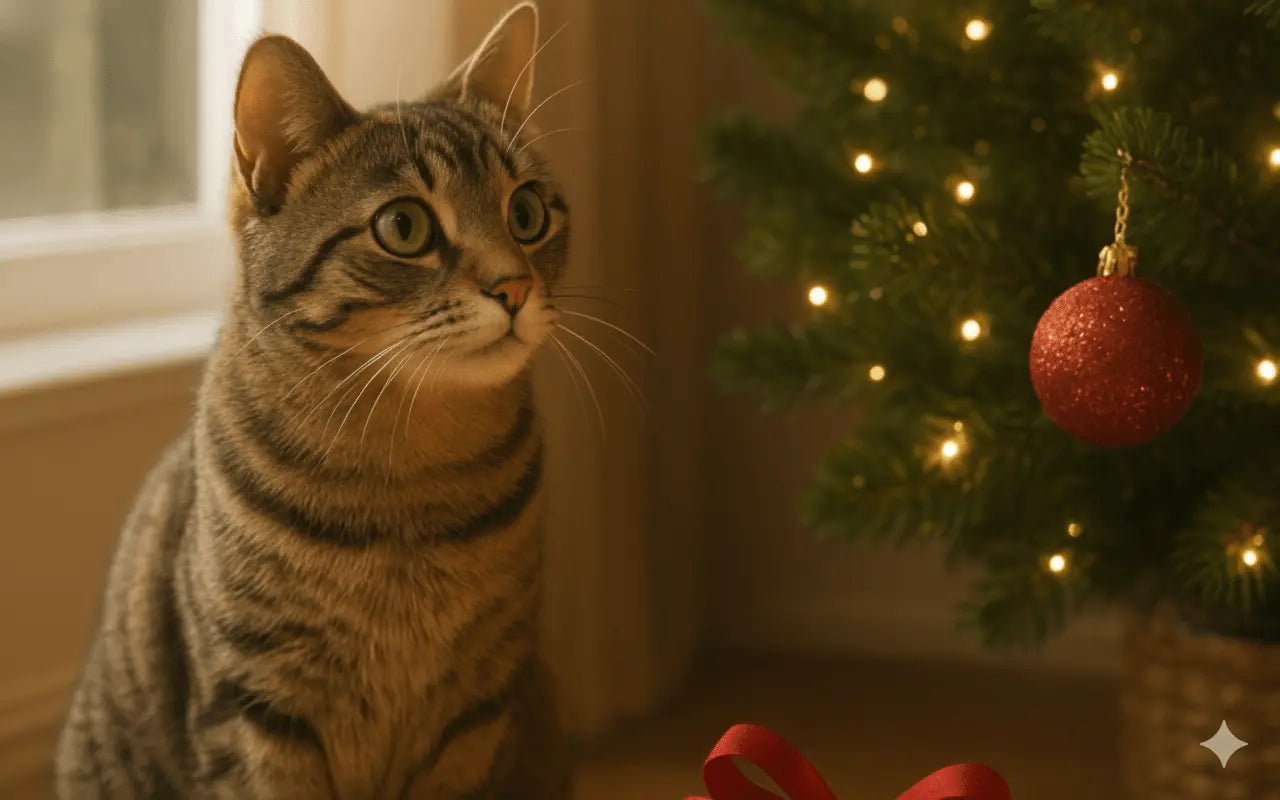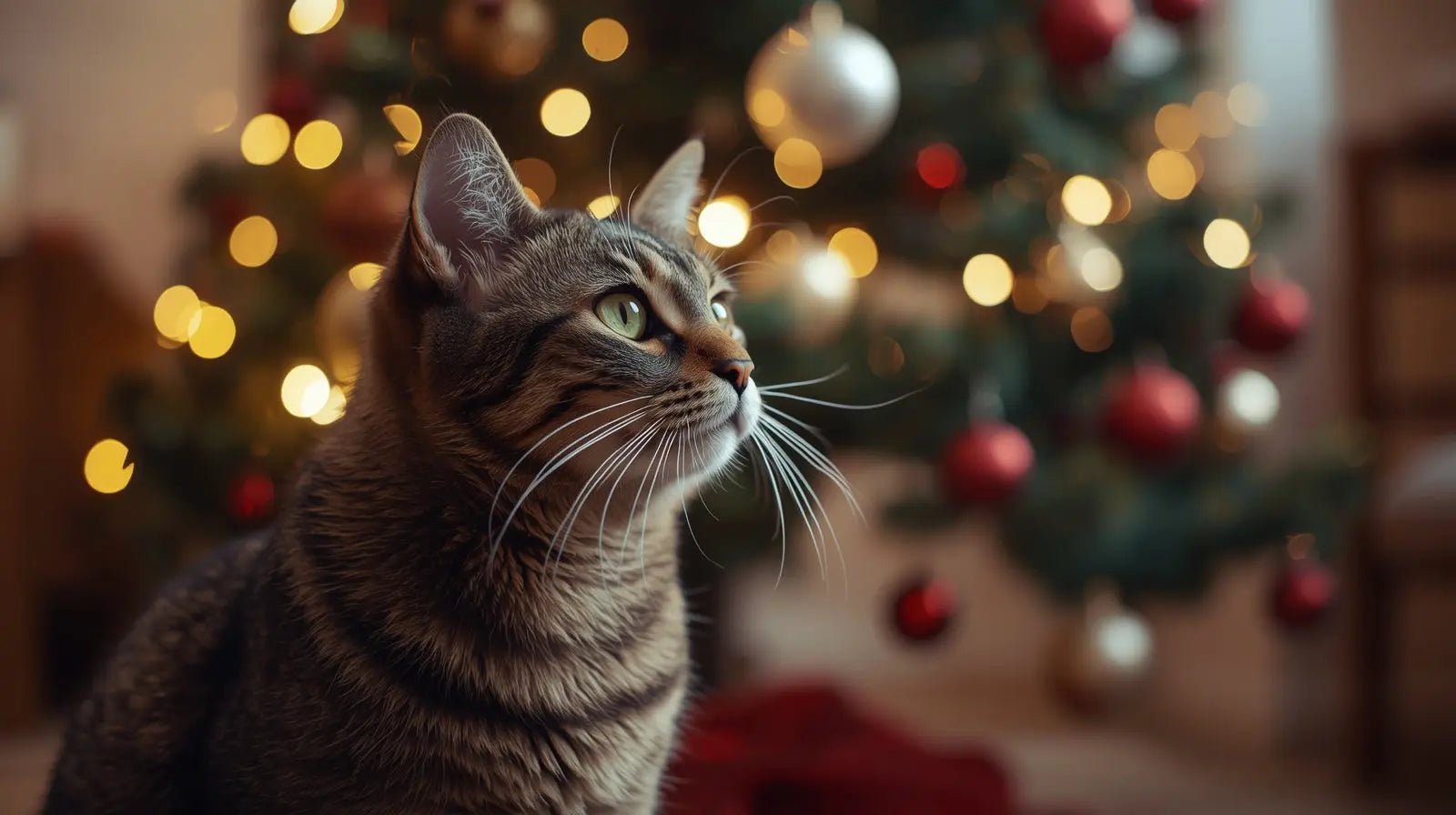
Cat Behavior Myths Around the Holidays

Your cat isn't sabotaging your holiday décor out of spite or plotting revenge for the tree taking over their favorite corner — they're just being a cat in a suddenly strange environment.
The holidays bring out assumptions about cat behavior that range from amusing to dangerously wrong.
"Cats hate Christmas." "They're jealous of the tree." "They're trying to ruin your decorations on purpose." These myths don't just misrepresent normal feline behavior — they prevent cat parents from addressing the real causes behind seasonal behavior changes.
We're busting the top holiday cat myths and explaining what's actually happening when your cat knocks ornaments off branches or zooms through the house at midnight. Hugo the Minskin has been labeled "naughty" more times than we can count, but understanding the truth behind his behavior transformed our entire holiday experience.
Myth vs. Reality
Let's separate fiction from feline fact.
Myth 1: Cats Attack Christmas Trees Out of Spite
Reality: Cats don't experience spite. They exhibit curiosity, a hunting drive, and a territorial instinct.
A Christmas tree is a unique vertical structure in its territory, characterized by movement (branches swaying), visual stimulation (lights reflecting), and dangling objects (ornaments) that trigger the prey drive. Your cat isn't being vindictive — they're responding to biological imperatives.
What's really happening:
-
The tree smells unfamiliar and must be investigated
-
Dangling ornaments mimic prey animals
-
Lights create motion that activates hunting reflexes
-
Climbing satisfies their need for elevated observation points
The solution: Provide alternative climbing structures nearby and use deterrents on the tree itself. You're redirecting instinct, not punishing malice.
Myth 2: Holiday Zoomies Mean Your Cat Is Hyperactive
Reality: Sudden bursts of energy (zoomies) are normal feline behavior that intensifies during holidays due to stress and disrupted routines.
Why do zoomies increase during holidays?
|
Trigger |
Why It Causes Zoomies |
|
Disrupted sleep |
Less rest = energy imbalance |
|
Stress accumulation |
Physical release of tension |
|
Reduced play time |
Unburned hunting energy |
|
Changes in routine |
Anxiety manifesting physically |
Hugo gets evening zoomies when his play schedule gets disrupted by guests. It's not hyperactivity — it's unspent predatory energy finding an outlet.
The solution: Maintain daily play sessions even during busy periods. Fifteen minutes of focused interactive play prevents midnight chaos.
Myth 3: Hiding Means Your Cat Is Antisocial
Reality: Hiding is a healthy coping mechanism, not a personality flaw.
Cats are both predators and prey animals. When their environment feels threatening (strangers, loud noises, unfamiliar smells), retreating to safety is an adaptive, not antisocial, response.
Signs of healthy hiding vs. problematic hiding:
-
Healthy: Cat emerges for food/water/litter, hides during peak stress, returns when the environment calms
-
Problematic: Won't emerge for 24+ hours, stops eating/drinking, shows signs of illness
Most holiday hiding is the healthy kind. Your cat is self-regulating stress, which is precisely what they should do.
The solution: Provide safe hiding spots and don't force interaction. Respect their need for space during overwhelming periods.
Myth 4: Cats Get Jealous of Holiday Attention
Reality: Cats don't experience jealousy as humans define it. They experience resource competition and routine disruption.
When you focus on decorating, hosting, or gift-giving, your cat notices the shift in your attention. But they're not emotionally wounded — they're responding to altered routines and competition for your time.
What looks like jealousy is actually:
-
Attention-seeking behavior because the play schedule changed
-
Stress from a disrupted routine
-
Resource guarding (you are a resource)
-
Normal requests for interaction
The solution: Maintain consistent interaction times. Five minutes of focused attention daily prevents most "jealous" behaviors.
Myth 5: Aggressive Behavior Is Meanness
Reality: Holiday aggression is almost always fear, stress, or overstimulation — never malice.
Common aggression triggers during holidays:
-
Too much petting (overstimulation)
-
Cornered by well-meaning guests
-
Territory feeling invaded
-
Pain from undiagnosed medical issues
-
Redirected aggression from stress
Hugo becomes "aggressive" (hisses, swats) when guests try to pick him up. He's not mean — he's setting boundaries with the tools available to him.
The solution: Learn your cat's warning signals and intervene before aggression becomes necessary. Stop interaction when you see flattened ears, tail twitching, or skin rippling.
Myth 6: Cats Don't Need Routine During Short Holiday Periods
Reality: Even brief routine disruptions can have a significant impact on cats. Their internal clocks are exact.
Cats thrive on predictability. Feeding times, play sessions, and sleep schedules anchor their sense of security. When these shifts — even for a "short" three-day holiday weekend — stress accumulates.
Impact of routine disruption:
-
Digestive upset
-
Sleep disturbances
-
Increased anxiety behaviors
-
Litter box issues
-
Attention-seeking or withdrawal
The solution: Maintain core routines (feeding, play, sleep) even when decorating, hosting, or traveling. These anchors prevent behavior problems before they start.
Our Custom Personalised Name Cat Food Mats help maintain consistent feeding locations, signaling routine stability even when everything else changes.
Reading Seasonal Signals
Understanding what your cat's behavior actually communicates changes everything.
Decoding Increased Vocalization
Myth: Excessive meowing is attention-seeking or manipulative.
Reality: Holiday vocalization increases usually signal stress, confusion, or unmet needs.
What different vocalizations mean:
-
Short, frequent meows: Greeting or request ("pay attention to me")
-
Long, drawn-out meows: Complaint or distress ("something feels wrong")
-
Yowling: High stress, pain, or territorial dispute
-
Chirping/trilling: Excitement or greeting (usually joyous)
Track when vocalization increases. If it happens during specific triggers (such as the doorbell ringing, guests arriving, or tree lights turning on), you've identified a stressor.
Response strategy: Address the underlying cause rather than the vocalization itself. Shouting at a stressed cat can increase its stress. Removing the trigger reduces the need to vocalize.
Understanding Destructive Scratching
Myth: Scratching furniture is revenge or dominance.
Reality: Scratching serves multiple biological purposes that intensify in response to environmental changes.
Why does scratching increase during holidays?
-
Territorial marking (new smells require re-marking territory)
-
Stress relief (physical activity releases tension)
-
Claw maintenance (self-care behavior)
-
Communication (visual and scent markers)
Where cats scratch reveals their motivation:
-
High-traffic areas (doorways, near trees): Territorial marking
-
Near their sleeping spots: Stretching and maintenance
-
New furniture or decorations: Investigating and claiming
The solution: Provide appropriate scratching surfaces near tempting areas. Place a scratching post next to the tree. Cover furniture temporarily with throws—trim nails weekly during holidays.
Appetite Changes Decoded
Myth: Not eating is stubbornness.
Reality: Changes in appetite signal stress or illness. Cats don't skip meals to make a point.
Common holiday eating patterns:
-
Decreased appetite: Stress, nausea from anxiety, food location changed, too much noise during meals
-
Increased appetite: Stress eating, less activity, burning fewer calories, seeking comfort
The solution: Maintain feeding schedules and locations. Feed in quiet areas away from holiday chaos. If your appetite drops for 24 hours or more, call your veterinarian.
Our Personalised Cat Photo Bowl creates a consistent, familiar feeding experience that reassures cats when everything else feels different.
Litter Box Behavior Changes
Myth: Urinating outside the box is spite or revenge.
Reality: Litter box avoidance always has a physical or environmental cause.
Holiday litter box issues stem from:
-
Box location near noisy areas
-
Changed litter brand or cleaning schedule
-
Urinary tract infection or blockage (medical emergency)
-
Box blocked by decorations or guests
-
Stress-induced behavioral issues
Critical distinction: Medical issues require immediate vet attention. Environmental issues require removing stressors.
The solution: Keep boxes in quiet, accessible locations. Scoop twice daily. Add extra boxes during holidays. Never punish litter box accidents — this can increase stress and worsen the problem.
Creating Supportive Environments
When you understand what behavior actually means, you can design spaces that support natural feline needs.
Provide Appropriate Outlets
-
For climbing instinct: Cat trees, wall shelves, and window perches positioned away from the holiday tree
-
For hunting drive: Daily interactive play, puzzle feeders, rotation of toys to maintain novelty
-
For territorial marking: Scratching posts in high-traffic areas, vertical and horizontal options
-
For retreat needs: Safe rooms with doors, covered beds, cardboard boxes, under-furniture access
Hugo has a cat tree explicitly positioned to give him tree-height observation without accessing the actual Christmas tree. This satisfies his urge to climb through an appropriate outlet.
Maintain Predictable Schedules
Non-negotiable daily elements:
-
Feeding times (±15 minutes maximum variance)
-
Play sessions (even 5-10 minutes help)
-
Quiet bedtime routine
-
Litter box maintenance
Everything else can be flexible, but these core routines must remain consistent. They're your cat's anchors during environmental chaos.
Respect Communication
When your cat signals discomfort — flattened ears, tail swishing, backing away — honor that communication immediately.
Boundary respect builds trust:
-
Stop petting when they show signs of overstimulation
-
Let them leave interactions freely
-
Don't chase or corner them
-
Allow hiding without forcing them out
Cats whose boundaries are consistently respected show fewer stress behaviors. They don't need to escalate to aggression because subtle signals work.
Reduce Sensory Overload
-
Volume control: Keep music and conversation at moderate levels
-
Light management: Use warm, steady lights rather than flashing effects
-
Scent caution: Avoid strong artificial fragrances in main living areas
-
Space preservation: Maintain furniture layouts that cats recognize
Small environmental controls prevent behavior problems before they develop.
Browse our Gifts for the Pet Lover collection for items that celebrate understanding your cat rather than misinterpreting them. From personalized bowls to custom photo products, each piece honors the real relationship you share.
FAQ
Is my cat really trying to ruin Christmas?
No. Cats don't have the cognitive capacity for spite or revenge. Behaviors that appear destructive are often responses to environmental triggers, such as curiosity, stress, the hunting instinct, or territorial defense. Understanding the real motivation helps you address the actual cause.
Why does my calm cat become aggressive during holidays?
Stress, overstimulation, and routine disruption lower tolerance thresholds. Your cat hasn't changed personality — they're responding to environmental pressure. Reduce stressors, maintain routines, and provide escape routes. "Aggression" often means "I'm overwhelmed and need space."
Can cats actually enjoy the holidays?
Yes, when their needs are met. Cats can enjoy novelty (new boxes to explore), special treats, extra attention from their people, and cozy seasonal spots. The key is meeting their need for routine and safety while adding festive elements.
Should I discipline my cat for holiday misbehavior?
No. Punishment increases stress and damages trust without addressing root causes. Instead, identify triggers, provide appropriate outlets, and manage the environment. Prevention beats punishment every time.
Final Thoughts
Holiday cat behavior isn't mysterious or malicious. It's a cat’s biology meeting in different environments.
When you stop interpreting natural responses as personality flaws, you can create solutions that actually work. Your cat isn't naughty — they're adapting to disruption the only way they know how.
Hugo's "holiday naughtiness" disappeared when we stopped trying to change him and started changing his environment. Understanding replaced frustration. Connection replaced conflict.
Your cat is doing its best with the tools it has. Meet them where they are, not where you wish they'd be.
Read the complete myth-busting guide at ChicKittyShop.com 🐱 | Follow @chickitty2023 ✨ Featuring @HugoTheMinskin
cat behavior myths, holiday cats, cat behavior explained, Christmas cat behavior, understanding cats




